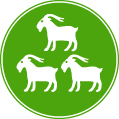Istrian Democratic Assembly
Istrian Democratic Assembly Istarski demokratski sabor Dieta democratica istriana | |
|---|---|
 | |
| Leader | Boris Miletić |
| Founded | 14 February 1990[1] |
| Headquarters | Pula, Croatia |
| Membership (2013) | 6,300[2] |
| Ideology |
Istrian regionalism Liberalism Social liberalism[3] Pro-Europeanism |
| Political position | Centre-left |
| National affiliation | Kukuriku coalition (2011-2015) |
| European affiliation | Alliance of Liberals and Democrats for Europe |
| International affiliation | Liberal International (observer) |
| European Parliament group | Alliance of Liberals and Democrats for Europe |
| Colours | Light green |
| Sabor |
3 / 151 |
| European Parliament |
1 / 11 |
| County Prefects |
1 / 21 |
| Mayors |
8 / 128 |
| Website | |
|
ids-ddi | |
The Istrian Democratic Assembly (Croatian: Istarski demokratski sabor, Italian: Dieta democratica istriana) is a regionalist[4] and liberal[5] political party in Croatia operating in the Istria region. The hyphenated abbreviation IDS-DDI is most commonly used.
Symbols
The three rams on the party coat of arms represent a historical symbol of the region, which is also represented by the ram in the fourth of the five parts of the crown resting atop the Croatian coat of arms (25-field white and red chequerboard) on the Croatian flag.
History
The party was founded in 1990 by Ivan Pauletta, Elio Martinčić and Mario Sandrić, on the eve of the first multi-party elections in Croatia after communism. The party decided not to participate, thus allowing the post-communist Social Democratic Party of Croatia (SDP) to sweep the region's votes.
The party was led by Ivan Jakovčić between 1991 and 2014.
IDS instead made its electoral debut in the 1992 elections and used the collapse of the SDP to take all three Istrian constituencies.
This result turned Istria into an area of significant concern for Croatian President Franjo Tuđman and his Croatian Democratic Union (HDZ), which had dominated every other region in Croatia. For the first elections for Croatian Chamber of Counties, which also coincided with the first election for newly formed Istria County, state-controlled media launched an unprecedented media blitz directed almost exclusively at Istria. This effort spectacularly backfired as Istrian voters gave almost three quarters of their votes to IDS. After that no party challenged IDS supremacy in Istria, at least not directly.
The main policy of the IDS is intercession of cultural and economical identity of Istria and equal status for Italian and Croatian in Istria. This was in opposition to Tuđman and his hard-line nationalism. Other Croatian political parties were more pragmatic, and IDS cooperated with them in the Croatian Parliament and during elections. In Istria, however, IDS is bitterly opposed by local branches of SDP, as well as their former member and first Istrian prefect Luciano Delbianco who had defected and formed a new party called Istrian Democratic Forum.
IDS was briefly part of the national government following 2000 parliamentary and presidential elections. One year later, IDS, dissatisfied with the way Ivica Račan and his coalition partners treated Istria, left the government, although they continued to support it in Parliament.
In 2006, IDS joined the Alliance of Liberals and Democrats for Europe (ALDE) Party.
From 2010-2015 IDS was a member of the Kukuriku coalition. Its member Darko Lorencin served as the minister of tourism in the Croatian government.
In the Croatian Parliament, Damir Kajin most frequently acted as the party's spokesperson, and he headed the party list in the 2007 elections where the party gained 3 representatives. Kajin was however removed from the party's membership on 3 January 2013 after forming his own coalition for the 2013 local elections in Istria.[6] This reduced the IDS from three to two representatives in the Croatian Sabor, and forced the party's parliamentary club to dissolve due to insufficient membership.
Electoral history
Parliament (Sabor)
| Election | In coalition with | Votes won | Percentage | Seats won | Change | Government |
|---|---|---|---|---|---|---|
| (Coalition totals) | (IDS only) | |||||
| 1992 (August) | DA-PGS | 83,623 | 3.18 (#7) | 4 / 138 |
|
Opposition |
| 1995 (October) | HSS-HNS-HKDU-SBHS | 441,390 | 18.26 (#2) | 3 / 127 |
|
Opposition |
| 2000 (January) | HSS-HNS-LS-SDA | 432,527 | 14.70 (#3) | 4 / 151 |
|
Government |
| 2003 (November) | SDP-LIBRA–LS | 560,593 | 22.6 (#2) | 4 / 151 |
|
Opposition |
| 2007 (November) | None | 38,267 | 1.5 (#4) | 3 / 151 |
|
Opposition |
| 2011 (December) | SDP-HNS–HSU | 958,312 | 40.4 (#1) | 2 / 151 |
|
Government |
| 2015 (November) | PGS-RI | 42,193 | 1.83 (#4) | 3 / 151 |
|
Opposition |
| 2016 (September) | PGS-RI | 43,180 | 2.27 (#5) | 3 / 151 |
|
Opposition |
European Parliament
| Election | In coalition with | Votes won (Coalition totals) | Percentage | Total seats won (IDS only) | Change |
|---|---|---|---|---|---|
| April 2013 | - | - | - | 0 / 12 |
|
| May 2014 | SDP-HNS–HSU-SDSS | 275,904 | 29,93% | 1 / 11 |
References
- ↑ "Istarski Demokratski Sabor" (PDF) (in Croatian). HIDRA. Retrieved 23 October 2011.
- ↑
- ↑ Parties and Elections in Europe: The database about parliamentary elections and political parties in Europe, by Wolfram Nordsieck
- ↑ Janusz Bugajski (1995). Ethnic Politics in Eastern Europe: A Guide to Nationality Policies, Organizations, and Parties. M.E. Sharpe. p. 461. ISBN 978-0-7656-1911-2.
- ↑ LUCIEN ELLINGTON (2004). Eastern Europe: An Introduction to the People, Land, and Culture. ABC-CLIO. p. 443. ISBN 978-1-57607-800-6.
- ↑ PREKRŠIO STRANAČKA PRAVILA Statut ga nije volio: Damir Kajin večeras izbrisan iz članstva IDS-a
External links
- Official website (Croatian)